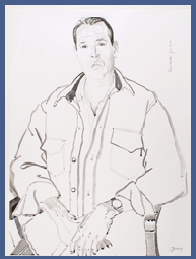 |

 aul
Monette published two more novels after Borrowed Time and
before Becoming a Man. Even with his added fame, he had
difficulty placing his first fiction in eight years. Both ended
up published by Crown Publishers, and editor David Groff worked
with Monette. In a long letter to Monette about editing Afterlife,
Groff wrote: "The book brought me to tears a few times. It's got
real power, and it's entirely new." The manuscript shown is carefully
marked by Groff in an editor's green pencil. aul
Monette published two more novels after Borrowed Time and
before Becoming a Man. Even with his added fame, he had
difficulty placing his first fiction in eight years. Both ended
up published by Crown Publishers, and editor David Groff worked
with Monette. In a long letter to Monette about editing Afterlife,
Groff wrote: "The book brought me to tears a few times. It's got
real power, and it's entirely new." The manuscript shown is carefully
marked by Groff in an editor's green pencil.
The two works are considered his greatest fictional achievements.
Afterlife (1990) unites his early flair for comedy and
depiction of Los Angeles and West Hollywood mores with a deeper
and a more bitter satire. Halfway Home (1991) uses a complex
exploration of family. Monette retained his anger at the establishment,
which he had expressed through his poetic persona and his own voice
in the previous AIDS books, but he channels his criticisms through
his fictional characters. Afterlife represents AIDS widowers
and a broad spectrum of gay men, including minorities. Halfway
Home creates a story of friends and family and allies supporting
each other in a healing process.
Although novelist and reviewer John Weir pointed to 1940s women's
movies as a stylistic source of Afterlife, Monette also
uses westerns and buddy movies to show the mix that gay men find
in their friendships. Afterlife appropriates Dumas's Three
Musketeers slogan, "All for one and one for all," to give a
heroic underpinning to the gay widowers' survival.
Halfway Home brings together Los Angeles history and geography—Malibu
rancho and movie colony, sea pine and eucalyptus. But for Monette's
protagonist with AIDS, the sun, the greatest Los Angeles attraction,
destroys T-cells and must be blocked. Monette's use of the relationship
between the straight brother and gay brother is a breakaway from
a gay novel with all gay characters, a turn toward what is now many
years later discussed as post-gay writing.
Monette took pride when talking about his newer fiction, in that
he kept these AIDS novels love stories: "Some of the writers that
I respect the most, the books that I respect the most—Dancer
from the Dance, for example, which I think is just a masterpiece—can
only be ironic about love. The characters wish to be romantics,
they wish to find somebody, but they don't, and that is the story
that is told." Monette's two last novels about AIDS remained stories
of realized love.
The Crown dust jackets for each novel are designs that would appeal
to gay men, as well as other readers. Afterlife uses one
David Hockney painting of a pool (no figures) for the hard cover
and another Hockney painting of a nude male figure at a pool for
the paperback reprint. Hockney was a great influence in creating
an iconography of Los Angeles, and here it is used to support Monette's
later "summer" imagery of the city.
In 1990 Monette also wrote an episode for the popular television
series, thirtysomething. One of the characters in this
long-running series is tested positive for the AIDS virus. Monette's
manuscript for "Positive" is fascinating, since he drafts the dialog
and directions in the small hand used for his fiction and poetry.
It is poignant to see among Monette's manuscript pages for Afterlife
one which is almost entirely consumed by notes for his AIDS medications.

|
|

First
leaf of Paul Monette's thirtysomething episode
Manuscript
leaf of Paul Monette's novel, Afterlife
Typescript
leaf of Afterlife
Manuscript
of Halfway Home
|

![]()
![]()
![]()
![]()

 aul
Monette published two more novels after Borrowed Time and
before Becoming a Man. Even with his added fame, he had
difficulty placing his first fiction in eight years. Both ended
up published by Crown Publishers, and editor David Groff worked
with Monette. In a long letter to Monette about editing Afterlife,
Groff wrote: "The book brought me to tears a few times. It's got
real power, and it's entirely new." The manuscript shown is carefully
marked by Groff in an editor's green pencil.
aul
Monette published two more novels after Borrowed Time and
before Becoming a Man. Even with his added fame, he had
difficulty placing his first fiction in eight years. Both ended
up published by Crown Publishers, and editor David Groff worked
with Monette. In a long letter to Monette about editing Afterlife,
Groff wrote: "The book brought me to tears a few times. It's got
real power, and it's entirely new." The manuscript shown is carefully
marked by Groff in an editor's green pencil.